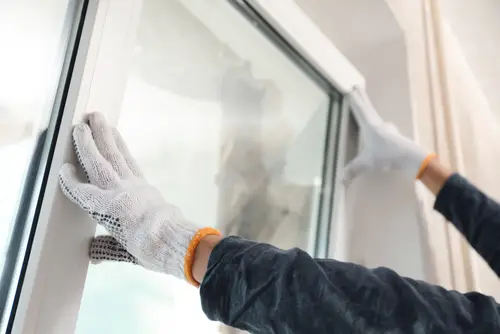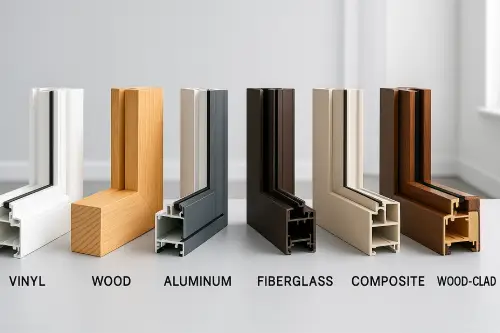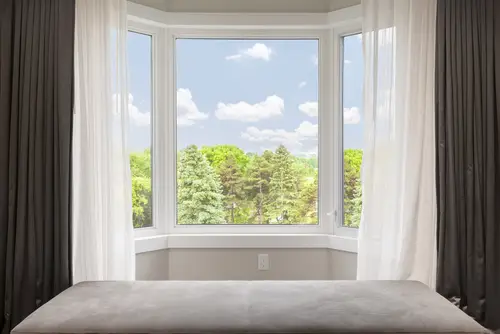Planning to replace your windows? Whether you’re dealing with chilly drafts or cracked glass, or just ready for an upgrade, the first question on homeowners’ minds is: How much will this cost me? Like most home projects, the answer depends on a few key factors.
In this guide, Mr. Handyman® breaks down considerations that impact window replacement cost, how much you can expect to pay in 2025, where hidden fees tend to show up, and how to save money without cutting corners. We’ll help you plan your project with clarity and confidence.
What to Know Before You Begin
Before you start comparing styles or shopping for materials, it’s helpful to understand what really affects the total cost to replace windows — and what hidden surprises can catch homeowners off guard.
- What’s included in your quote? Some estimates only cover the cost of the window itself, not installation, trim work, disposal, or prep. Always ask for a line-item quote to avoid last-minute surprises.
- Location affects labor costs. Replacing a window on the first floor is usually faster (and cheaper) than one on a second story, over a staircase, or in a tight spot. Access matters.
- Energy-efficient windows cost more upfront, but save over time. Double- or triple-pane glass, Low-E coatings, and gas-filled insulation can help lower your utility bills. Some energy-efficient windows may even qualify for tax rebates or energy incentives.
- Permits may be required. Depending on your location, full-frame window replacement might require a permit, especially in historic homes or multifamily units. Check with your local installer or municipality.
- Timing your project can affect cost. Spring and fall are the busiest times for window installers. Scheduling your replacement during slower months (like mid-winter or late summer) could mean faster turnaround and better pricing.
|
Mr. Handyman Tip: Replacing multiple windows at once? Ask if your installer offers a bulk discount — many do, and the savings can add up quickly. |
Now that you know what to expect going in, let’s break down the average cost to replace windows in 2025 — including what’s driving those numbers up (and how to keep them down).
How Much Does Window Replacement Cost in 2025?
Replacing all the windows in a house may cost from $3,500 to $12,000 or more — an average of $7,500 for a window replacement project. The number and size of windows being replaced are significant factors in the overall cost of the project. For instance, larger windows take longer to remove and install, which increases labor costs.
Why such a wide range?
Costs vary based on location, window material, labor rates, and how difficult the installation is. For example, second-story or tight-fit installs typically take longer and cost more. Not all estimates include removal or disposal of old windows, so be sure to ask for a comprehensive cost breakdown with your quote.
|
Mr. Handyman Tip: Replacing multiple windows at once often reduces your cost per window. Many pros offer volume discounts. Doing it all at once can save on labor, too. |

Window Frame Materials and Their Cost Ranges

The type of window frame you choose has the most significant impact on the total project cost. Some materials are budget-friendly and low maintenance, while other options offer premium styles and long-term energy efficiency, but at a higher initial cost.
Here’s what you can expect to pay for new windows (not including installation):
- Vinyl windows: $150–$800. Vinyl is the most popular choice for a reason — it’s affordable, energy-efficient, and easy to maintain in most climates.
- Aluminum windows: $200–$1,200. Aluminum is lightweight and durable, with a sleek, modern look. It’s not the best insulator, but it works well in dry or mild environments.
- Wood windows: $300–$1,200. Classic and beautiful, wood frames are best for traditional homes, but require more upkeep and are usually priced higher.
- Fiberglass windows: $300–$1,500. Strong, stable, and highly energy-efficient, fiberglass windows are a smart pick for homes in areas with extreme temperature swings.
- Composite windows: $300–$1,500. Composite frames are made from blended materials for the look of wood with better durability and weather resistance.
- Wood-clad / Aluminum-clad windows: $400–$1,800. Wood- and aluminium-clad frames combine interior aesthetics with an exterior protective finish. Great for high-end designs and curb appeal.
|
Mr. Handyman Tip: If you live in an area with harsh winters or humid summers, fiberglass or composite frames may cost more upfront, but they’ll perform better and last longer with less maintenance. |
Once you’ve picked your frame material, the next major price factor is the window style. This is where costs can really start to fluctuate.
Window Styles and How They Impact Replacement Cost

Not all windows are created equal, and the style you choose can have a major impact on your total replacement cost. Some styles are simple, stylish, and affordable; others are larger, more decorative, and require more complex installation.
Here’s what you can expect to pay for the most common window styles (not including labor and installation):
Budget-friendly styles
- Single-Hung: $150–$400. A basic option where only the bottom sash opens. Simple to use; often installed in standard bedrooms or garages.
- Double-Hung: $300–$800. Both sashes move, making them easier to clean and better for airflow. Popular in most homes.
- Sliding: $200–$800. Opens horizontally. Great for wide views and low-profile spaces like basements or patios.
Mid-Range Options
- Casement: $300–$1,000. Hinged on the side, cranks open outward. Excellent energy efficiency and ventilation.
- Picture: $300–$1,200. A fixed window that doesn’t open, but provides clear views and lots of natural light.
- Awning: $350–$900. Hinged at the top, opens outward. Useful for adding airflow in small bathrooms or tight spaces.
Premium or Custom Styles
- Bay/Bow: $1,000–$3,500. Multi-panel windows that extend outward for extra space and natural light. Beautiful but complex to install.
- Garden: $800–$2,500. Box-style windows that protrude out and act like mini greenhouses — great near kitchen sinks.
- Skylight: $300–$2,000. Roof-mounted windows that let in overhead light. Costs vary based on roof type and framing needs.
- Custom: $500–$5,000. Fully custom shapes and sizes tailored to your home. Greater design flexibility equates to higher cost due to special framing and fabrication.
The bottom line: Larger, more complex windows cost more, not just in materials, but in labor, too. Stick to standard sizes and styles if you're looking to maximize value and minimize surprises.
|
Mr. Handyman Tip: Ask your installer about multi-room pricing or discounts for larger jobs. Combining rooms into one project can lower your per-window cost and minimize repeat labor fees. |
How to Save Money on Window Replacement
Replacing windows adds comfort, curb appeal, and energy efficiency — but you don’t have to overspend to get the job done right. With a few smart choices, you can reduce your costs while still getting high-quality results.
Here are practical ways to cut costs without cutting corners:
- Stick to standard sizes. Custom-shaped or oversized windows cost more to manufacture and install. If your openings allow, standard-size replacements are often cheaper and easier to source.
- Choose budget-friendly materials. Vinyl is the most affordable option for many homeowners — plus, it’s durable, low maintenance, and energy efficient. Fiberglass and composite also offer long-term value, but cost more up front.
- Bundle your project. Replacing multiple windows at once is more efficient for installers and may come with lower labor rates per window. Ask if your pro offers multi-room or whole-home pricing.
- Do some prep work yourself. Clear furniture, remove curtains, and make sure installers have easy access. Some pros charge for these tasks, so handling them yourself can reduce labor time.
- Ask about rebates or incentives. ENERGY STAR®-certified windows may qualify for local or federal rebates, utility discounts, or tax credits. These incentives can help offset upfront costs.
- Get a few estimates. Comparing quotes gives you a clearer picture of fair pricing and helps you avoid hidden markups or low-ball offers that sacrifice quality.
- Consider repairs for minor issues. If your windows are drafty but not damaged, resealing or replacing glass panes might be more cost-effective than full replacement. (More on this next.)
When budgeting for window replacement, it pays to be strategic. Start with the biggest energy drains, like drafty living rooms or older, north-facing windows. Upgrading those first can help you start enjoying a return on your investment as early as possible.
Should You Repair or Replace Your Windows?
Not all window problems call for a full replacement! Knowing how to recognize repairable issues can help you save a lot of time and money.
Here’s how to tell if your windows need repair or replacement:
When to schedule repairs:
- You see foggy or cracked glass, but the frame is solid.
- The window sticks or won’t open properly, often due to paint or humidity.
- There’s minor air leakage around the frame that could be sealed.
- The issue is isolated to one window, not your entire home.
When to consider replacement:
- Your windows are drafty or causing energy loss.
- The frames show rot, warping, or signs of water damage.
- You want to upgrade energy efficiency or curb appeal.
- You’re remodeling or updating multiple rooms.
- Several windows are outdated or beyond repair.
Most well-maintained windows last 15 to 30 years, depending on the material and climate. Mr. Handyman’s window repair experts can assess your window’s condition, explain the pros and cons of both options, and help you ensure the best long-term value for your home and budget.
Why Trust Mr. Handyman for Window Replacement?
Window replacement should be done right the first time — and that’s exactly what we’re known for. Our service professionals have an average of 10 years of experience, handling everything from window removal and prep to precise installation and sealing. Whether you're replacing one window or many, we tailor our service to your home, your goals, and your budget. All of our services are backed by the Neighborly Done Right Promise® to ensure your satisfaction.
Ready to explore window replacement? Our local service professionals are here to help. Reach out to your local Mr. Handyman team to get started on your project!
This article is intended for general informational purposes only and may not be applicable to every situation. You are responsible for determining the proper course of action for your home and property. Mr. Handyman is not responsible for any damages that occur as a result of this blog content or your actions. For the most accurate guidance, contact your local Mr. Handyman location for a comprehensive, on-site assessment.
FAQs About Window Replacement Cost
Mr. Handyman has been helping homeowners and businesses repair, maintain, and enhance their spaces for over 25 years! We are the one-stop solution for everything on your to-do list. This includes answering your questions about home repairs, maintenance, and improvements. Here are answers to some of your most frequently asked questions on window replacement cost.
What is the average cost to replace windows?
The average cost to replace windows ranges from $300 to $1,400 per window, not counting labor. Full-home window replacement projects typically fall between $7,000 and $15,000, depending on how many windows you need, your home’s layout, and labor rates in your area.
What affects the total cost to replace windows?
The most significant factors affecting the cost of window replacement include window style, size, frame material, energy efficiency features, and installation complexity. Labor costs vary by region and project scope. Disposal fees and permits may also affect your quote.
Always make sure you receive a detailed written estimate to avoid last-minute surprises.
What’s the average labor cost to install windows?
Labor alone usually costs $100 to $400 per window, but this can vary based on access, window type, and your home’s condition. Higher floors, large custom frames, or tricky removal jobs tend to cost more, especially in high-demand metro areas.
What’s the most affordable way to replace windows?
To replace windows on a budget, choose standard-size vinyl windows. Handle basic prep work yourself to minimize labor costs. Finally, ask your installer about possible volume discounts for larger jobs, and try to schedule as many replacements as possible in one visit.
Can I just replace the glass instead of the full window?
Yes — if your window frames are intact, replacing the insulated glass unit (IGU) alone may solve fogging or cracks without the expense of a frame replacement. A professional can inspect your windows and recommend whether glass repair or a full glass replacement makes more sense.
Should I repair or replace my windows?
If your frames are solid and issues are minor, such as fogging or small chips, repairs may be enough. But if you're dealing with drafts, water damage, or rising energy bills, replacement is usually the better investment. A professional can help you weigh both options.
Are new windows really worth the investment?
Yes — new windows can improve your home’s comfort, energy efficiency, and resale value. According to the National Association of Realtors®, homeowners recoup up to 68% of the cost of new windows at resale, while saving monthly on heating and cooling.




